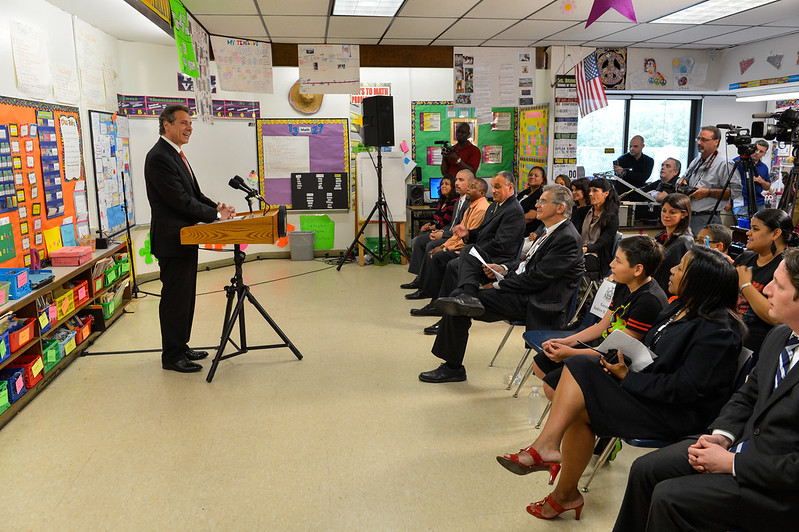
(photo: the governor's office)
Our broken system of school finance is currently the subject of roundtables led by the State Senate's new Democratic majority. The hearings are focused on reforming the Foundation Aid formula that determines the bulk of state aid to local districts.
Broken? According to the Alliance for Quality Education, the gap between the average per pupil spending in the 100 wealthiest and 100 poorest school districts has grown to a record $10,218 per pupil. These stark differences are reflected in teacher salaries and class sizes, counselors and librarians, facilities, and technology, among other social and academic supports. Flowing from these inequities are pervasive proficiency challenges among students of color in our poorest districts, robbing them of their inherent rights to educational and economic justice.
The school finance system has long been a source of political in-fighting. The Foundation Aid "pie" is largely dictated by the Governor through the executive’s power over the state budget. The Legislature then slices the pie among the state's 750 school districts based on a combination of need and political muscle. In Albany, that's not a fair fight.
The winners tend to be wealthier suburban swing districts where voters keep close tabs on their elected representatives to bring home maximum funding. Every dollar in state aid is a dollar less in local property taxes, the driver of the inequitable system of American school finance where school quality it directly related to the property wealth of its citizens.
Individual legislators’ accountability to rural and urban school districts is less direct and party control of these seats more assured. As a result, school aid is not the make-or-break electoral issue it is in the suburbs. The profound effect of this political mismatch is that the needier districts are disproportionately dealt out of Foundation Aid, which was originally meant to close the gap.
So merely reforming Foundation Aid will not solve the problem of inequitable and inadequate state aid. The formula is broken because, at bottom, it is based on political rather than educational considerations. The solution is to rearrange the legal equation to reflect educational finance as a right, not subject to the exigencies of political might. We need to see the issue as one of promoting the civil rights of all students.
Solving such a big problem requires a big idea: a constitutionally required escalator that automatically raises the level of each district’s state funding to match per pupil spending by our wealthiest districts. This new funding structure based on a standard of educational excellence would permanently correct the otherwise intractable power imbalance favoring wealthy districts, bringing a new level of educational quality to all the states’ children and an ensuing level of prosperity for all New Yorkers.
The Excellence Escalator: How It Works
Today, our state constitution provides a lowest common denominator right to a “sound basic education” pegged at the level of a “meaningful high school education” by the New York State Court of Appeals in its 2003 opinion in Campaign for Fiscal Equity v. State of New York (“CFE II”). The Foundation Aid formula was developed in response to CFE II but has never realized its promise of meeting the fiscal equity demanded by the Court of Appeals decree. Stifled by the iron rule of political power, the CFE II and its predecessor and successor decisions have proven of little use in Albany’s hotbed of competing school district interests vying for self-limited state funds.
Moving beyond the false promise of judicial rescue through Foundation Aid will require a constitutional amendment to replace the Court of Appeals’ “sound basic education” adequacy standard with a standard of “educational excellence” tied to funding levels our wealthiest residents deem appropriate for their own children.
The excellence escalator will assure that state aid meets or exceeds the per pupil spending in our wealthiest districts. While expensive, the sticker shock of the state providing highest-level funding can be mitigated by adjustment of aid for individual district measures of student need and local capacity, formulaic data already available and largely immune to political manipulation.
In practice, our wealthiest districts would receive zero state dollars but no ceiling on local spending. Districts of similar wealth that chose not to tax at that level would also receive zero by failing to meet local capacity. But districts that taxed to the max would be rewarded by state assistance to meet the highest levels of per pupil district spending.
As a result, the excellence escalator is less radical that it seems. It does not discourage local spending and maintains local school taxes as the bulwark of our system of school finance. But, as a constitutional guarantee, the provision assures that the state will match funding to levels of real world spending that currently benefits only our most well-off students.
Besides providing a greater degree of educational equity, the escalator would dramatically encourage desegregation by removing a major obstacle to families’ movement between districts: the quality of schools. By diminishing the gap in per pupil spending between districts, a major reason for our entrenched enclavism, a growing hole in our social fabric could be mended.
The path forward for the excellence escalator is not free of the same politics that currently traps us in the broken system of Foundation Aid. But it is a one-time fix, requiring approval by two successive legislative sessions and a voter referendum. Today’s problem is a constant battle, fought every year against impossible odds. A constitutionally mandated school funding excellence escalator would turn the tide toward educational equity and quality, a big idea whose time has come.
***
David C. Bloomfield is Professor of Educational Leadership, Law and Policy at Brooklyn College and The CUNY Graduate Center. This essay is adapted from testimony presented to the New York Advisory Committee to the U.S. Commission on Civil Rights. On Twitter @BloomfieldDavid.
***
Have an op-ed idea or submission for Gotham Gazette? Email This email address is being protected from spambots. You need JavaScript enabled to view it.




